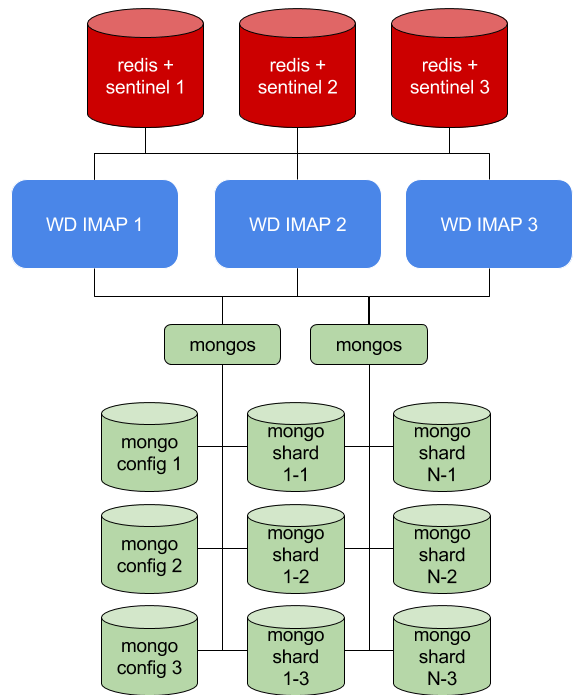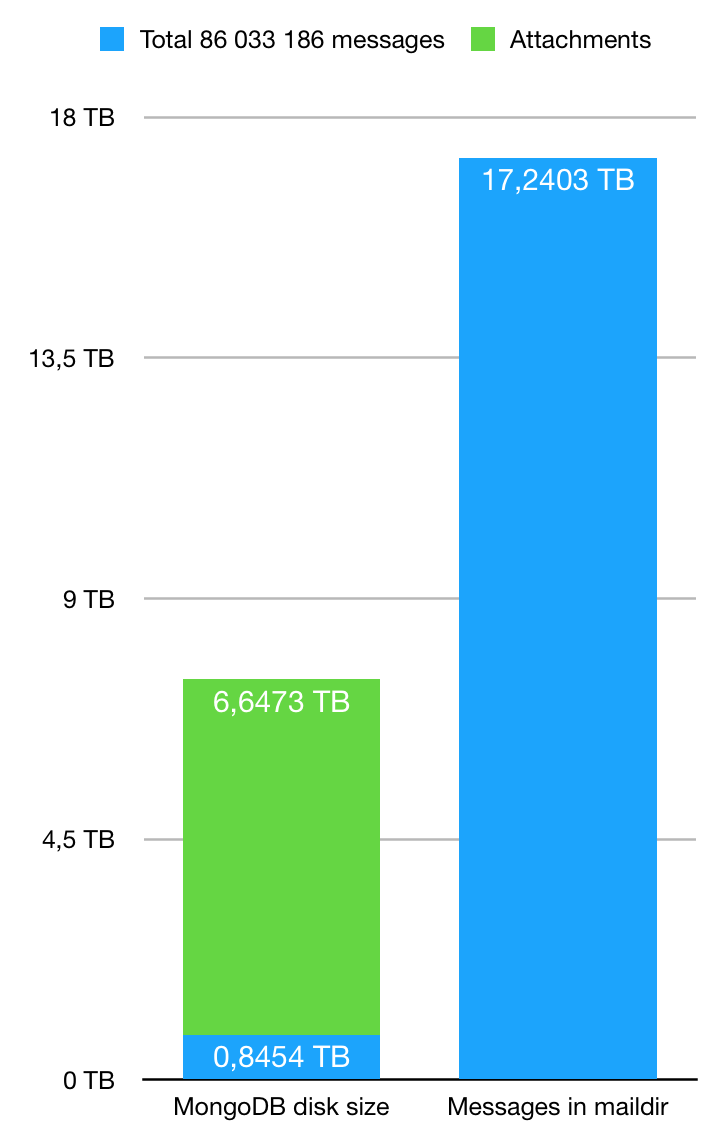WildDuck is a scalable no-SPOF IMAP/POP3 mail server. WildDuck uses a distributed database (sharded + replicated MongoDB) as a backend for storing all data, including emails.
WildDuck tries to follow Gmail in product design. If there's a decision to be made then usually the answer is to do whatever Gmail has done.
NB! WildDuck is currently in beta. Use it on your own responsibility.
- MongoDB to store all data
- Redis for pubsub and counters
- Node.js at least version 6.0.0
Optional requirements
- Redis Sentinel for automatic Redis failover
- Build tools to install optional dependencies that need compiling
WildDuck can be installed on any Node.js compatible platform.
Every component of the WildDuck mail server can be replicated which eliminates potential single point of failures.
Attachment de-duplication and compression gives up to 56% of storage size reduction.
If you have a blank VPS and a free domain name that you can point to that VPS than you can try out the scripted all-included install
Install script installs and configures all required dependencies and services, including Let's Encrypt based certs, to run WildDuck as a mail server.
Tested on a 10$ DigitalOcean Ubuntu 16.04 instance.
- Web interface at https://wildduck.email that uses WildDuck API
Assuming you have MongoDB and Redis running somewhere.
$ git clone git://github.com/nodemailer/wildduck.git
$ cd wildduck
Install dependencies from npm
$ npm install --production
To use the default config file, run the following:
node server.js
Or if you want to override default configuration options with your own, run the following (custom config file is merged with the default, so specify only these values that you want to change):
node server.js --config=/etc/wildduck.toml
For additional config options, see the wild-config documentation.
See API Docs for details about creating new user accounts
Any IMAP or POP3 client will do. Use the credentials from step 4. to log in.
- Build a scalable and distributed IMAP/POP3 server that uses clustered database instead of single machine file system as mail store
- Allow using internationalized email addresses
- Provide Gmail-like features like pushing sent messages automatically to Sent Mail folder or notifying about messages moved to Junk folder so these could be marked as spam
- Provide parsed mailbox and message data over HTTP. This should make creating webmail interfaces super easy, no need to parse RFC822 messages to get text content or attachments
Users, mailboxes and messages can be managed with HTTP requests against WildDuck API
Yes, it does. You can run the server and get working IMAP and POP3 servers for mail store, LMTP server for pushing messages to the mail store and HTTP API server to create new users. All handled by Node.js, MongoDB and Redis, no additional dependencies needed. Provided services can be disabled and enabled one by one so, for example you could process just IMAP in one host and LMTP in another.
Read about WildDuck security implementation from the Wiki
- Stateless. Start as many instances as you want. You can start multiple WildDuck instances in different machines and as long as they share the same MongoDB and Redis settings, users can connect to any instances. This is very different from the traditional IMAP servers where a single user always needs to connect (or be proxied) to the same IMAP server. WildDuck keeps all required state information in MongoDB, so it does not matter which IMAP instance you use.
- Scalable as WildDuck uses sharded MongoDB cluster for the backend storage. If you're running out of space, add a new shard.
- No SPOF. You can run multiple instances of every required service.
- Centralized authentication which allows modern features like 2FA, application specific passwords, authentication scopes, revoking authentication tokens, audit logging and even profile files to auto-configure Apple email clients without master password
- Works on any OS including Windows. At least if you get MongoDB and Redis running first.
- Focus on internationalization, ie. supporting email addresses with non-ascii characters
- Deduplication of attachments. If the same attachment is referenced by different messages then only a single copy of the attachment is stored.
- Access messages both using IMAP and HTTP API. The latter serves parsed data, so no need to fetch RFC822 messages and parse out html, plaintext content or attachments. It is super easy to create a webmail interface on top of this.
- Built in address labels: username+label@example.com is delivered to username@example.com
- Dots in usernames and addresses are informational only. username@example.com is the same as user.name@example.com
- HTTP Event Source to push modifications in user email account to browser for super snappy webmail clients
- Super easy to tweak. The entire codebase is pure JavaScript, so there's nothing to compile or anything platform specific. If you need to tweak something then change the code, restart the app and you're ready to go. If it works on one machine then most probably it works in every other machine as well.
- Better disk usage. Attachment deduplication and MongoDB compression yield in about 40% smaller disk usage as the sum of all stored email sizes.
- Extra security features like automatic GPG encryption of all stored messages or authenticating with U2F
- Exposed logs. Users have access to logs concerning their account. This includes security logs (authentication attempts, changes on account) and also message logs
Yes, historically it has been considered a bad practice to store emails in a database. And for a good reason. The data model of relational databases like MySQL does not work well with tree like structures (email mime tree) or large blobs (email source).
Notice the word "relational"? In fact document stores like MongoDB work very well with emails. Document store is great for storing tree-like structures and while GridFS is not as good as "real" object storage, it is good enough for storing the raw parts of the message. Additionally there's nothing too GridFS specific, so (at least in theory) it could be replaced with any object store.
Here's a list of alternative email servers that also use a database for storing email messages:
- DBMail (MySQL, IMAP)
- Archiveopteryx (PostgreSQL, IMAP)
- ElasticInbox (Cassandra, POP3)
Whenever a message is received WildDuck parses it into a tree-like structure based on the MIME tree and stores this tree to MongoDB. Attachments are removed from the tree and stored separately in GridStore. If a message needs to be loaded then WildDuck fetches the tree structure first and, if needed, loads attachments from GridStore and then compiles it back into the original RFC822 message. The result should be identical to the original messages unless the original message used unix newlines, these might be partially replaced with windows newlines.
WildDuck tries to keep minimal state for sessions (basically just a list of currently known UIDs and latest MODSEQ value) to be able to distribute sessions between different hosts. Whenever a mailbox is opened the entire message list is loaded as an array of UID values. The first UID in the array element points to the message nr. 1 in IMAP, second one points to message nr. 2 etc.
Actual update data (information about new and deleted messages, flag updates and such) is stored to a journal log and an update beacon is propagated through Redis pub/sub whenever something happens. If a session detects that there have been some changes in the current mailbox and it is possible to notify the user about it (eg. a NOOP call was made), journaled log is loaded from the database and applied to the UID array one action at a time. Once all journaled updates have applied then the result should match the latest state. If it is not possible to notify the user (eg a FETCH call was made), then journal log is not loaded and the user continues to see the old state.
WildDuck IMAP server supports the following IMAP standards:
- The entire IMAP4rev1 suite with some minor differences from the spec. See below for IMAP Protocol Differences for a complete list
- IDLE (RFC2177) – notfies about new and deleted messages and also about flag updates
- CONDSTORE (RFC4551) and ENABLE (RFC5161) – supports most of the spec, except metadata stuff which is ignored
- STARTTLS (RFC2595)
- NAMESPACE (RFC2342) – minimal support, just lists the single user namespace with hierarchy separator
- UNSELECT (RFC3691)
- UIDPLUS (RFC4315)
- SPECIAL-USE (RFC6154)
- ID (RFC2971)
- MOVE (RFC6851)
- AUTHENTICATE PLAIN (RFC4959) and SASL-IR
- APPENDLIMIT (RFC7889) – maximum global allowed message size is advertised in CAPABILITY listing
- UTF8=ACCEPT (RFC6855) – this also means that WildDuck natively supports unicode email usernames. For example андрис@уайлддак.орг is a valid email address that is hosted by a test instance of WildDuck
- QUOTA (RFC2087) – Quota size is global for an account, using a single quota root. Be aware that quota size does not mean actual byte storage in disk, it is calculated as the sum of the RFC822 sources of stored messages.
- COMPRESS=DEFLATE (RFC4978) – Compress traffic between the client and the server
WildDuck more or less passes the ImapTest Stress Testing run. Common errors that arise in the test are
unknown labels (WildDuck doesn't send unsolicited FLAGS updates even though it does send unsolicited FETCH FLAGS updates) and sometimes NO for STORE
(messages deleted in one session can not be updated in another).
In comparison WildDuck is slower in processing single user than Dovecot. Especially when fetching messages, which is expected as Dovecot is reading directly from filesystem while WildDuck is recomposing messages from different parts.
Raw read/write speed for a single user is usually not relevant anyway as fetching entire mailbox content is not something that happens often. WildDuck offers better parallelization through MongoDB sharding, so more users should not mean slower response times. It is also more important to offer fast synchronization speeds between clients (eg. notifications about new email and such) where WildDuck excels due to the write ahead log and the ability to push this log to clients.
In addition to the required POP3 commands (RFC1939) WildDuck supports the following extensions:
- UIDL
- USER
- PASS
- SASL PLAIN
- PIPELINING
- TOP
All changes to messages like deleting messages or marking messages as seen are stored in storage only in the UPDATE stage (eg. after calling QUIT). Until then the changes are preserved in memory only. This also means that if a message is downloaded but QUIT is not issued then the message does not get marked as Seen.
POP3 listing displays the newest 250 messages in INBOX (configurable)
WildDuck uses message _id value (24 byte hex) as the unique ID. If a message is moved from one mailbox to another then it might re-appear in the listing.
If a messages is downloaded by a client this message gets marked as Seen
If a messages is deleted by a client this message gets marked as Seen and moved to Trash folder
WildDuck has built-in message filtering in LMTP server. This is somewhat similar to Sieve even though the filters are not scripts.
Filters can be managed via the WildDuck API.
This is a list of known differences from the IMAP specification. Listed differences are either intentional or are bugs that became features.
\Recentflags is not implemented and most probably never will be (RFC3501 2.3.2.)RENAMEdoes not touch subfolders which is against the spec (RFC3501 6.3.5. If the name has inferior hierarchical names, then the inferior hierarchical names MUST also be renamed.). WildDuck stores all folders using flat hierarchy, the "/" separator is fake and only used for listing mailboxes- Unsolicited
FLAGSresponses (RFC3501 7.2.6.) andPERMANENTFLAGSare not sent (except for as part ofSELECTandEXAMINEresponses). WildDuck notifies about flag updates only with unsolicited FETCH updates. - WildDuck responds with
NOforSTOREif matching messages were deleted in another session CHARSETargument for theSEARCHcommand is ignored (RFC3501 6.4.4.)- Metadata arguments for
SEARCH MODSEQare ignored (RFC7162 3.1.5.). You can define<entry-name>and<entry-type-req>values but these are not used for anything SEARCH TEXTandSEARCH BODYboth use MongoDB $text index against decoded plaintext version of the message. RFC3501 assumes that it should be a string match either against full message (TEXT) or body section (BODY).- What happens when FETCH is called for messages that were deleted in another session? Not sure, need to check
- Autoexpunge, meaning that an EXPUNGE is called on background whenever a messages gets a
\Deletedflag set. This is not in conflict with IMAP RFCs.
Any other differences are most probably real bugs and unintentional.
Create an email account and use your IMAP client to connect to it. To send mail to this account, run the example script:
node examples/push-message.js username@example.com
This should "deliver" a new message to the INBOX of username@example.com by using the built-in LMTP maildrop interface. If your email client is connected then you should promptly see the new message.
Use WildDuck MTA (which under the hood is ZoneMTA with the ZoneMTA-WildDuck plugin).
This gives you an outbound SMTP server that uses WildDuck accounts for authentication. The plugin authenticates user credentials and also rewrites headers if needed (if the header From: address does not match user address or aliases then it is rewritten). Additionally a copy of the sent message is uploaded to the Sent Mail folder. Local delivery is done directly to WildDuck LMTP.
Use Haraka with queue/lmtp plugin to deliver messages to WildDuck and haraka-plugins-wildduck to validate recipient addresses and quota usage against the WildDuck users database.
-
Optimize FETCH queries to load only partial data for BODY subparts
-
Parse incoming message into the mime tree as a stream. Currently the entire message is buffered in memory before being parsed.
-
Maybe allow some kind of message manipulation through plugins
-
WildDuck does not plan to be the most feature-rich IMAP client in the world. Most IMAP extensions are useless because there aren't too many clients that are able to benefit from these extensions. There are a few extensions though that would make sense to be added to WildDuck:
WildDuck supports MongoDB sharding. Consider using sharding only if you know that your data storage is large enough to outgrow single replica. Some actions require scattered queries to be made that might be a hit on performance on a large cluster but most queries include the shard key by default.
Shard the following collections by these keys (assuming you keep attachments in a separate database):
sh.enableSharding('wildduck');
// consider using mailbox:hashed for messages only with large shard chunk size
sh.shardCollection('wildduck.messages', { mailbox: 1, uid: 1 });
sh.shardCollection('wildduck.archived', { user: 1, _id: 1 });
sh.shardCollection('wildduck.threads', { user: 'hashed' });
sh.shardCollection('wildduck.messagelog', { id: 'hashed' });
sh.shardCollection('wildduck.authlog', { user: 'hashed' });
sh.enableSharding('attachments');
// attachment _id is a sha256 hash of attachment contents
sh.shardCollection('attachments.attachments.files', { _id: 'hashed' });
sh.shardCollection('attachments.attachments.chunks', { files_id: 'hashed' });Tests show that the ratio of attachment contents vs other stuff is around 1:10. This means that you can split your database between multiple disks by using
smaller SSD (eg. 150GB) for message data and indexes and a larger and cheaper SATA (eg. 1TB) for attachment contents. This assumes that you use WiredTiger with
storage.directoryPerDB:true and storage.wiredTiger.engineConfig.directoryForIndexes:true
Assuming that you use a database named attachments for attachment contents:
SSD mount : /var/lib/mongodb
SATA mount: /var/lib/mongodb/attachments/collection
MongoDB does not complain about existing folders so you can prepare the mount before even installing MongoDB.
WildDuck is able to use Redis Sentinel instead of single Redis master for automatic failover. When using Sentinel and the Redis master fails then it might take a moment until new master is elected. Pending requests are cached during that window, so most operations should succeed eventually. You might want to test failover under load though, to see how it behaves.
Redis Sentinel failover does not guarantee consistency. WildDuck does not store critical information in Redis, so even if some data loss occurs, it should not be noticeable.
When using HAProxy you can enable PROXY protocol to get correct remote addresses in server logs. You can use the most basic round-robin based balancing as no persistent sessions against specific hosts are needed. Use TCP load balancing with no extra settings both for plaintext and TLS connections.
If TLS is handled by HAProxy then use the following server config to indicate that WildDuck assumes to be a TLS server but TLS is handled upstream
[imap]
secure=true # this is a TLS server
secured=true # TLS is handled upstream
[pop3]
secure=true # this is a TLS server
secured=true # TLS is handled upstreamYou can live-reload updated certificates by sending SIGHUP to the master process. This causes application configuration to be re-read from the disk. Reloading only affects only some settings, for example all TLS certificates are loaded and updated. In this case existing processes continue as is, while new ones use the updated certs.
Beware though that if configuration loading fails, then it ends with an exception. Make sure that TLS certificate files are readable for the WildDuck user.
WildDuck Mail Agent is licensed under the European Union Public License 1.1 or later.



